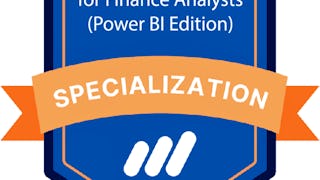Filter by
SubjectRequired
LanguageRequired
The language used throughout the course, in both instruction and assessments.
Learning ProductRequired
LevelRequired
DurationRequired
SkillsRequired
SubtitlesRequired
EducatorRequired
Explore the UML Diagram Course Catalog

Duke University
Skills you'll gain: Database Design, MySQL, Relational Databases, SQL, Data Modeling, Databases, Business Analytics, Big Data, Business Analysis, Data Analysis, Data Management

University of Colorado System
Skills you'll gain: Database Design, Data Warehousing, Relational Databases, Decision Support Systems, Business Intelligence, Data Modeling, Database Management Systems, Databases, Dashboard, Business Process Management, SQL, Star Schema, Data Governance, Data Integration, Oracle Databases, Performance Measurement, Extract, Transform, Load, Business Analytics, MicroStrategy, Data Visualization Software

University of Toronto
Skills you'll gain: ArcGIS, Spatial Data Analysis, Spatial Analysis, Geographic Information Systems, Geospatial Mapping, GIS Software, Data Mapping, Data Visualization, Metadata Management, Query Languages, Global Positioning Systems, Quantitative Research, Data Compilation, Data Modeling, Typography, Data Manipulation, Data Processing, Data Storytelling, Design Elements And Principles, Image Analysis

Corporate Finance Institute
Skills you'll gain: Data Analysis Expressions (DAX), Power BI, Snowflake Schema, Data Modeling, SQL, Business Intelligence, Dashboard, Microsoft Excel, Excel Formulas, Pivot Tables And Charts, Data Import/Export, Business Reporting, Databases, Interactive Data Visualization, Data Storytelling, Financial Statements, Data Analysis Software, Data Manipulation, Data Analysis, Relational Databases

University of Alberta
Skills you'll gain: Software Architecture, Model View Controller, Unified Modeling Language, Object Oriented Design, Service Oriented Architecture, API Design, Systems Architecture, Web Services, Software Design Patterns, Software Design, Simple Object Access Protocol (SOAP), Microservices, Restful API, Software Design Documents, Software Visualization, Code Review, Solution Architecture, Software Systems, Object Oriented Programming (OOP), Java

LearnQuest
Skills you'll gain: Oracle SQL Developer, SQL, Oracle Databases, PL/SQL, Database Design, Database Theory, Database Management Systems, Database Administration, Relational Databases, Database Management, Databases, Database Software, Database Architecture and Administration, Data Storage, Transaction Processing, Stored Procedure, Data Access, Data Modeling, Network Architecture, Data Integrity
 Status: AI skills
Status: AI skillsSkills you'll gain: Data Storytelling, Business Metrics, Key Performance Indicators (KPIs), Data Management, Data Collection, Data Governance, Bayesian Statistics, Data Analysis, Descriptive Statistics, Statistical Hypothesis Testing, Information Privacy, Data Cleansing, Pandas (Python Package), Data Visualization Software, Statistical Inference, Spreadsheet Software, Correlation Analysis, Google Sheets, Exploratory Data Analysis, Data Modeling

University of Minnesota
Skills you'll gain: User Story, Agile Software Development, Software Design Patterns, Design Thinking, Software Development Methodologies, Software Design, Agile Methodology, Agile Project Management, Engineering Software, Process Mapping, Software Engineering, Kanban Principles, Software Development Life Cycle, Software Quality Assurance, Program Development, Application Security, Scrum (Software Development), User Experience Design, Requirements Analysis, Lean Methodologies
 Status: AI skills
Status: AI skillsSkills you'll gain: Data Storytelling, Business Metrics, Key Performance Indicators (KPIs), Marketing Analytics, Bayesian Statistics, Descriptive Statistics, Marketing Effectiveness, Statistical Hypothesis Testing, Target Audience, Marketing Strategies, Data Cleansing, Pandas (Python Package), Data Modeling, Data Analysis, Data Visualization Software, Spreadsheet Software, A/B Testing, Data Collection, Marketing, Interviewing Skills

University of California, Davis
Skills you'll gain: Spatial Data Analysis, Spatial Analysis, ArcGIS, Geographic Information Systems, Geospatial Mapping, Data Quality, Data Mapping, Data Modeling, Data Storage, Data Sharing, Data Manipulation, Relational Databases, Query Languages

Skills you'll gain: Power BI, Microsoft Copilot, Data Visualization Software, Data Storytelling, Data Modeling, Interactive Data Visualization, Data Analysis, Microsoft Power Platform, Microsoft Azure, Extract, Transform, Load, Data Transformation, Data Cleansing, Data Security

University of Pennsylvania
Skills you'll gain: Regression Analysis, Spreadsheet Software, Google Sheets, Financial Modeling, Microsoft Excel, Data Modeling, Forecasting, Risk Analysis, Probability & Statistics, Business Modeling, Statistical Analysis, Simulation and Simulation Software, Process Improvement and Optimization
UML Diagram learners also search
In summary, here are 10 of our most popular uml diagram courses
- Managing Big Data with MySQL: Duke University
- Data Warehousing for Business Intelligence: University of Colorado System
- GIS, Mapping, and Spatial Analysis: University of Toronto
- BI Essentials for Finance Analysts (Power BI Edition): Corporate Finance Institute
- Software Design and Architecture: University of Alberta
- Oracle SQL Databases: LearnQuest
- Meta Data Analyst: Meta
- Software Development Lifecycle: University of Minnesota
- Meta Marketing Analytics: Meta
- GIS Data Formats, Design and Quality: University of California, Davis










